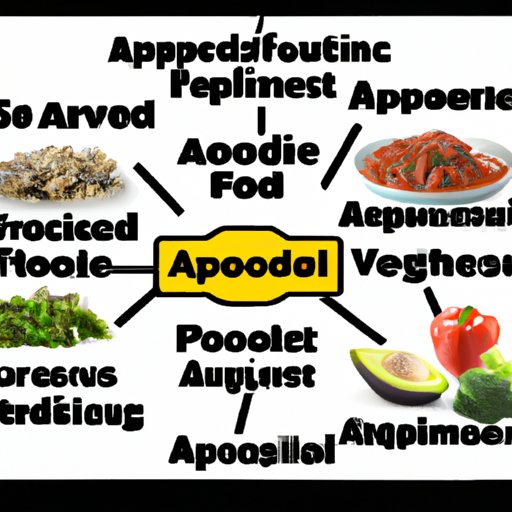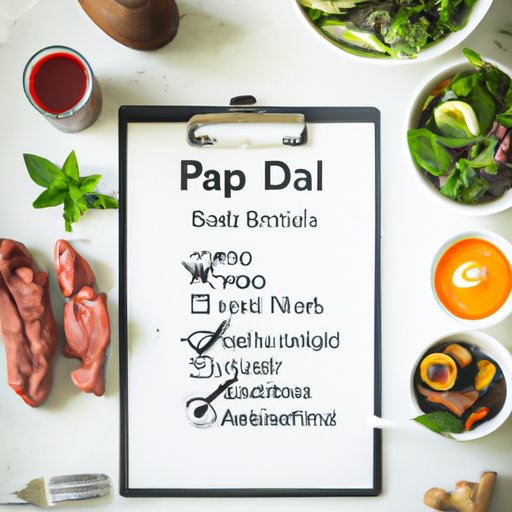Introduction
The Paleo diet is based on the idea of eating as our hunter-gatherer ancestors did before the advent of modern farming methods. It’s a way of eating that focuses on fresh, whole foods such as fruits, vegetables, nuts, seeds, and grass-fed meats. The idea is to avoid processed foods and limit added sugars, grains, and legumes. The goal is to provide your body with all the nutrients it needs to stay healthy and energized.
There are numerous benefits to following a Paleo diet, including improved digestion, increased energy levels, better overall health, and weight loss. Since it focuses on whole foods, it’s also an excellent way to get more vitamins, minerals, and phytochemicals in your diet. Plus, since it limits processed foods, it helps reduce your exposure to unhealthy additives and preservatives.

Approved Foods and Their Benefits
The list of approved Paleo diet foods includes fruits, vegetables, nuts, seeds, grass-fed meat, fish, eggs, and some oils. These foods are nutrient-rich and provide your body with the vitamins, minerals, and phytonutrients it needs for optimal health. Here’s a closer look at each food group and their respective benefits:
Fruits: Fruits are full of antioxidants, fiber, and essential vitamins and minerals. Eating plenty of fruit can help protect against diseases like cancer and heart disease, as well as aid in weight control. Choose fresh or frozen fruits whenever possible.
Vegetables: Vegetables are packed with essential vitamins, minerals, and fiber. Eating plenty of vegetables can help reduce inflammation, lower blood pressure, and improve digestion. Aim to eat a variety of colors when selecting vegetables.
Nuts and Seeds: Nuts and seeds are excellent sources of healthy fats, protein, and fiber. Eating them regularly can help keep you feeling fuller longer and reduce cholesterol levels. Try to opt for raw and unsalted versions of these foods whenever possible.
Grass-Fed Meats: Grass-fed meats are rich in essential amino acids, B vitamins, and omega-3 fatty acids. Eating grass-fed meats can help improve heart health, reduce inflammation, and increase energy levels. Look for organic, grass-fed options whenever possible.
Fish: Fish is an excellent source of lean protein and healthy omega-3 fatty acids. Eating fish regularly can help reduce inflammation, improve heart health, and boost brain function. Aim to include both fatty and non-fatty fish in your diet.
Eggs: Eggs are a great source of protein and essential vitamins and minerals. Eating eggs regularly can help improve eye health, boost brain function, and reduce inflammation. Look for organic, free-range eggs whenever possible.
Oils: Oils like olive, coconut, and avocado oil contain healthy fatty acids and can be used to cook and prepare meals. Use these oils sparingly as they are high in calories.
Meal Plan Ideas
Creating a meal plan can help make sticking to a Paleo diet easier. Here’s a sample weekly meal plan to get you started:
Monday: Breakfast – Scrambled eggs with spinach and mushrooms; Lunch – Grilled salmon salad with mixed greens and olive oil; Dinner – Baked chicken breast with roasted broccoli and sweet potatoes.
Tuesday: Breakfast – Greek yogurt with berries and almonds; Lunch – Turkey and avocado wrap with lettuce; Dinner – Grilled steak with roasted Brussels sprouts and cauliflower.
Wednesday: Breakfast – Smoothie bowl with banana, almond butter, and chia seeds; Lunch – Cobb salad with grilled chicken, bacon, and hard-boiled egg; Dinner – Baked salmon with roasted asparagus and quinoa.
Thursday: Breakfast – Egg and vegetable frittata; Lunch – Tuna salad with lettuce and tomato; Dinner – Grilled pork chops with mashed sweet potatoes and sautéed spinach.
Friday: Breakfast – Avocado toast with tomatoes and poached eggs; Lunch – Kale and apple salad with grilled chicken; Dinner – Baked cod with roasted cauliflower and mushrooms.
Saturday: Breakfast – Chia seed pudding with almond milk and blueberries; Lunch – Grilled shrimp salad with cucumber and bell peppers; Dinner – Grilled turkey burgers with roasted sweet potatoes and broccoli.
Sunday: Breakfast – Omelet with vegetables and feta cheese; Lunch – Spinach salad with grilled chicken and avocado; Dinner – Baked salmon with roasted Brussels sprouts and quinoa.
To make meal planning easier, try prepping meals ahead of time. You can cook large batches of proteins, vegetables, and starches so they’re ready to go during the week. This will save you time and help ensure you’re eating healthy meals throughout the day.

Comparison to Other Popular Diets
The Paleo diet is just one of many popular diets out there. To compare, here’s a look at some of the other popular diets and how they compare to the Paleo diet:
Ketogenic Diet: The ketogenic diet is a low-carb, high-fat diet that focuses on getting most of your calories from fats. It’s designed to put your body into a state of ketosis, where it burns fat instead of carbs for fuel. While this diet has been shown to be effective for weight loss, it can be difficult to maintain and is not recommended for everyone.
Vegan Diet: A vegan diet eliminates all animal products, including meat, dairy, and eggs. It focuses on plant-based foods such as fruits, vegetables, nuts, seeds, and grains. It’s an excellent way to get more vitamins, minerals, and phytonutrients in your diet, but it can be difficult to get enough protein without animal products.
Mediterranean Diet: The Mediterranean diet is based on the traditional foods eaten in countries like Greece and Italy. It emphasizes fresh fruits and vegetables, healthy fats, and lean proteins. It’s an excellent way to get more healthy fats and fiber in your diet and can help reduce your risk of heart disease.
When comparing the Paleo diet to these other popular diets, it’s important to consider your individual needs. The Paleo diet may be beneficial for those looking to lose weight and improve their overall health, but it’s not right for everyone. Be sure to do your research and consult with a healthcare professional before starting any new diet.
Interviews with People Who Have Adopted the Paleo Diet
Hearing stories from people who have adopted the Paleo diet can be incredibly inspiring. Here are a few stories from people who have successfully adopted the Paleo diet and the challenges they faced along the way:
Greg: “I was overweight and had digestive issues when I first decided to try the Paleo diet. I was skeptical at first, but after a few weeks, I noticed a huge improvement in my energy levels and digestion. I also lost 10 pounds in the first month!”
Janice: “I was diagnosed with autoimmune disease and knew I needed to make a change in my diet. I was hesitant to try the Paleo diet because I love bread and pasta, but I’m glad I did. It’s made a huge difference in my health and I now feel better than ever.”
John: “I was always tired and lacked energy before I switched to the Paleo diet. After making the switch, I noticed I had more energy and felt better overall. I still struggle with cravings for sweets, but I’ve learned to find healthier alternatives to satisfy my sweet tooth.”
These stories show that adopting the Paleo diet can be challenging, but it’s worth it in the end. With dedication and commitment, you can make the switch and reap the rewards of a healthier, happier life.
Simple Substitutions to Create Paleo-Friendly Recipes
It’s easy to create delicious Paleo-friendly recipes using simple substitutions. For example, you can swap out white flour for almond or coconut flour in baking recipes. You can also use mashed banana or applesauce in place of sugar to sweeten recipes. Here are a few other simple substitutions you can make to create Paleo-friendly recipes:
Traditional Pizza: Swap out the traditional pizza crust for a cauliflower crust. Top with your favorite Paleo-friendly ingredients like grilled chicken, bell peppers, mushrooms, and olives.
Pasta Dishes: Substitute traditional pasta for spiralized zucchini or spaghetti squash. Top with your favorite Paleo-friendly sauce, such as marinara or pesto.
Sandwiches: Swap out the bread for a lettuce wrap or portobello mushroom bun. Fill with your favorite Paleo-friendly ingredients like grilled chicken, avocado, and tomatoes.
Smoothies: Ditch the dairy and swap in coconut or almond milk. Add your favorite Paleo-friendly fruits and vegetables, such as bananas, strawberries, spinach, and kale.
Conclusion
The Paleo diet is a great way to get more whole foods into your diet and improve your overall health. It focuses on fresh, unprocessed foods such as fruits, vegetables, nuts, seeds, and grass-fed meats. There are numerous benefits to following a Paleo diet, including improved digestion, increased energy levels, better overall health, and weight loss. Plus, it’s easy to create Paleo-friendly recipes using simple substitutions.
If you’re considering the Paleo diet, it’s important to do your research and consult with a healthcare professional. Everyone’s needs are different, so make sure you find a diet that works for you. With dedication and commitment, you can make the switch and reap the rewards of a healthier, happier life.
(Note: Is this article not meeting your expectations? Do you have knowledge or insights to share? Unlock new opportunities and expand your reach by joining our authors team. Click Registration to join us and share your expertise with our readers.)
